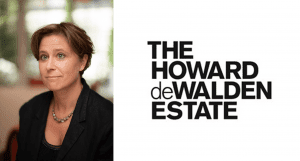
Can you tell us a bit about your background, where you’ve been, what you’re doing now and where you’re moving on to?
With a keen interest in architecture, music, culture and most importantly, people, it felt inevitable that I’d gravitate to Marylebone. Having studied at Cambridge University in the early 90’s, I moved to Marylebone and began my career as an architect. One of our clients was the Howard de Walden Estate (HdWE), one of the key landowners in Marylebone and it was already clearly evident at that point what a difference the business was making to the area. It had ambitious regeneration plans for Marylebone High Street, under the sharp and creative direction of the then Chief Executive, Andrew Ashenden.
After a while in architecture, a great opportunity came up for me to move into the film industry, where I worked on the design of some very exciting film sets. I carried on this work for some years but continued to live in Marylebone and always kept in close contact with Andrew. We both shared a love of Marylebone, architecture and creative thinking generally. In 2003 I joined HdWE to work directly with Andrew on some new ideas and after some time became the Creative Director. I was with the company for 16 ½ years carrying out some very exciting and fulfilling roles as Creative Director and more recently as Place & Community Director.
I have just stepped down from the company to pursue my own ventures, something I have wanted to do for a while. The intention is to work with a mix of people and organisations, providing strategic thought, advice and support on a range of subjects. I have quite an unusual, mixed interest background and having worked client-side with HdWE for so long, I am well placed to turn my hand and mind to various challenges. That’s what excites me about this next step. I will of course continue to have my home in Marylebone and support HdWE and Marylebone long into the future.
How has your community investment program evolved at your company?
Investment in the community can happen in many ways and HdWE provides a great example of what can be achieved with some creative thought. Shortly after starting at HdWE, I set up the Marylebone Summer Festival. The original idea was to bring together the community on a Sunday. Although hard to imagine today, shops at the time closed at midday on Saturday and nothing was open on a Sunday, it was dead. The event, albeit small, was a success and not only got Sunday life in Marylebone up and running, it also provided a very useful opportunity to raise money and awareness for nominated charities. The event has grown from strength to strength, spreading to over a weekend, attracting approximately 30,000 people and raising great funds for charity. Added to this Sunday is probably the busiest day in Marylebone now, I think we did a few things right!
HdWE does a lot of work behind the scenes creating and supporting initiatives and events that bring its community together, without which the area would be a very different place. This includes the Christmas Lights switch-on, the creation and publication of the Marylebone Journal – now run in collaboration with The Portman Estate – featuring information on exciting community activities in Marylebone, and donations to support causes such as the Royal Society of Medicine, the Wigmore Hall, the Royal Academy of Music and the two state-funded church schools.
What is your biggest accomplishment so far?
In addition to its charitable work, and building on the company’s ability to gather communities, some years ago we set our sights on building a designated brand identity for our medical community to celebrate the amazing work done in and around Harley Street. Some of the finest medical operators reside in this area and the abundance of medical excellence available to people was neither fully understood, nor advertised. As the predominant landowner, with unrivalled relationships with these operators, we set about establishing a mechanism for different medical businesses and organisations to come together to have a greater impact. Since then the Harley Street Medical Area Partnership has been established with the intention of it becoming a BID (Business Improvement District) in 2021. This will be a great achievement by HdWE and something I have been very proud to have been a driving part of. There are numerous BID’s in London today and all do tremendous work around public realm, place shaping, networking and building better environments for their communities. A Harley Street Medical Area BID will join this mix and I hope will be such a force for good.
How do you stay inspired?
For me, it’s always been about people. HdWE has some of the finest Georgian architecture in London, (obviously in my view!), an abundance of beautiful buildings. But without people, these buildings are merely bricks and mortar. It’s the people that bring the buildings to life and make the buildings, and the spaces in between, become real spaces and, ultimately, thriving communities.
People have always been the key driver for the work I have tried to do at HdWE, whether setting up street events, a local journal, a marketing and events team or running a charitable arm. It always comes back to what impact does this have on people. When I wander around the Marylebone Summer Festival and see everyone enjoying themselves, it can be really quite exhilarating.
Meeting the beneficiaries of HdWE’s charitable work has to be the most rewarding part. A recent example would be, meeting the two students who this year received our accommodation grant to help them cover their living costs in London. One of the students, who was previously working two jobs to pay his way, has been able to give up most of this work to focus on his studies, ahead of his final year exams. Hearing how the grant was changing his life and his hopes of what he could now achieve, was inspiring.
How do you see community investment evolving, both in your company, your sector and in general? Will philanthropy continue? Will there be more of a focus on certain beneficiaries?
Our primary role is essentially looking after 92 acres of land in central London. This encompasses buildings and spaces which all need constant upgrading and maintaining in order to attract people who want to live, work and visit the area.
We’ll need to further consider the role of a responsible landlord, how we can develop sustainable buildings and what their purpose is, and who will use them. There’s big environmental questions around energy performance and energy sources and how our buildings and places are made to interact with new smart appliances and products, such as electric vehicles. What central London will look like, and how people will function within it, even in 10 years from now, I think will be very different from how it is today. This, of course, offers very exciting challenges ahead but equally makes heavy demands. If we are going to achieve our business and wider social aims, we’re going to need to keep refining how we look at things, in different ways, from different perspectives.
The good news is that a business like HdWE is so well placed to do this, as it thinks ahead and is not swayed by short-term gain. This will be one of the keys to success. HdWE will also, without question, continue to be a force for good. I think this will happen through the day-to-day running of HdWE regarding their holdings, but I also see it shaping the way the charitable and sustainability work develops.
One thing is certain, in the days ahead, we will all need to employ a more flexible and open-minded approach as we pass through times of immense evolution and change. I see the role of community investment, engagement, and sustainability being firmly embedded within the main disciplines of every business that deals with the built environment.
